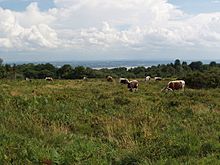Poor's Allotment facts for kids
| Site of Special Scientific Interest | |

Poor's Allotment with grazing cattle
|
|
| Area of Search | Gloucestershire |
|---|---|
| Coordinates | 51°41′19″N 2°38′14″W / 51.688475°N 2.637178°W |
| Interest | Biological |
| Area | 28.57 hectare |
| Notification | 1954 |
Poor's Allotment is a special natural area in Gloucestershire, England. It covers about 28.57 hectares, which is roughly the size of 70 football fields! This site is known as a biological Site of Special Scientific Interest (SSSI). This means it's a protected area because it has unique plants and habitats that are important for nature. It was first recognized as a special place in 1954.
Today, Poor's Allotment is part of a bigger nature reserve that's 60 hectares in size. This larger area is called The Park & Poor's Allotment. It's looked after by the Gloucestershire Wildlife Trust, an organization that helps protect wildlife. Part of the land is owned by trustees from the Tidenham parish, and another part is managed with the Forestry Commission.
Contents
Where is Poor's Allotment?
Poor's Allotment is located in Gloucestershire. The ground beneath the site is made up of different types of rocks. Some parts have carboniferous rocks from the Forest of Dean. Other areas have heath plants growing on Drybrook sandstone. There are also parts where plants grow on Drybrook limestone, which has a lot of calcium.
Because of these different rock types, the site has many kinds of habitats. This makes Poor's Allotment very important for nature in the region. Long ago, in 1814, this land was set aside to help people in the nearby parishes of Lancaut and Tidenham. It has always been used for grazing animals and offers great views of the local area.
Plants and Habitats
Poor's Allotment has several different types of natural areas. You can find acidic grassland here, which is a type of grassy land with acidic soil. There are also areas of lowland heath, which are open spaces with small shrubs. Some parts have thick patches of bracken, a type of fern.
In the south-east part of the site, the soil is different. It's made of limestone, which means it has a lot of calcium. This soil supports a different kind of plant life, including calcareous grassland and broad-leaved woodland.
Heathland Plants
The heathland areas are home to many interesting plants. You might see grasses like Common bent, Sheep's Fescue, and Creeping Fescue. There are also large areas covered in Western gorse, which has bright yellow flowers, and Ling, a type of heather. Other plants found here include Bell Heather, Cross-leaved Heath, Bilberry, Sheep's Sorrel, and Heath Bed-straw.
Limestone Grassland and Woodlands
The calcareous grassland, which grows on limestone soil, has many types of fescue grasses. You can also find beautiful herbs like Rock rose, Thyme, Stemless thistle, Salad Burnet, and Bird's-foot Trefoil.
The wooded parts of Poor's Allotment have trees such as Oak, Holly, Yew, Field Maple, and Whitebeam. On the ground beneath the trees, you might spot plants like Dog's Mercury and Bluebell.
Rare Plants and Wetland Areas
Recently, some rare plants have been found at Poor's Allotment. These include Flea Sedge, Soft-leaved sedge, Autumn-ladies tresses, Star sedge, and Lesser skullcap. Another interesting plant found here is Alder buckthorn.
Towards the middle of the site, there's a spring that feeds a pond. This wet area is a great home for many small creatures without backbones, called invertebrates. You can also find lots of wetland plants growing along the edges of the pond.

